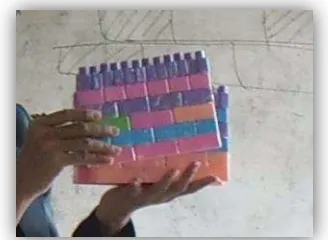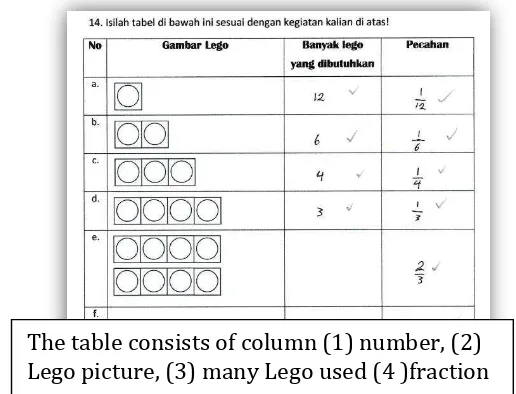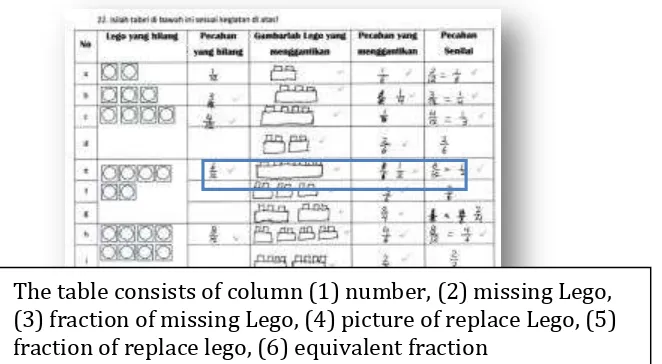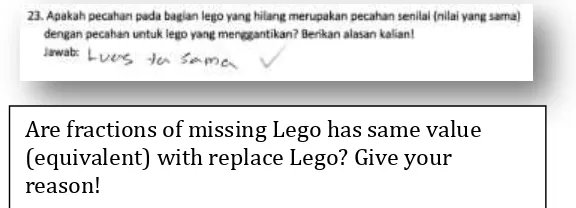SUPPORTING STUDENT’S UNDERSTANDING OF EQUIVALENT
FRACTION CONCEPT USING LEGO WITH AREA MODEL
Feli Ramury1, Yusuf Hartono2, Ratu Ilma Indra Putri3
Sriwijaya University1,2,3)
punja_ramury@yahoo.com1), y_hartono@unsri.ac.id2) ratu.ilma@yahoo.com3)
Abstract
This research aimed to investigate how Lego can support student’s understanding of equivalent fraction concept with area model in fourth grade. This study was based PMRI that associated with thematic integrative learning curriculum 2013. The method used was design research of type validation study that aimed to prove the theories of learning. This research consists of three stages; preliminary design, teaching experiments, and retrospective analysis were chosen to achieve the research objectives. The research was conducted on 21 fourth graders in SDN 16 Lembak. Students learning activities that were conducted including: 1) determine the fractions as parts of a whole using Lego which students get a fraction with take of Lego piece that covers the whole, and 2) determine the equivalent fraction of fractions formed from Lego which students compare area of missing Lego pieces and area replace parts. Understanding of equivalence fraction concept obtained from the size or area of missing Lego with replace part. This study was focus on first stage of the teaching experiment. The results of this study indicate that a series of activities can help students to understand of equivalent fraction concept.
Keywords : equivalent fraction, Lego, PMRI approach, design research
INTRODUCTION
One of the most difficult and crucial mathematical topics for students with mathematical learning difficulties has been the study of fractions (Wastenskow, 2012; van de Walle, Karp, & Bay-Williams, 2013; Mamede, Ema, 2010; Streefland, 1991). One of the basic and essential ideas in understanding fractions to be mastered is equivalent fractions (Battista, 2012; Wastenskow, 2012). Beside that understanding equivalent fraction are also critical when students encounter problems involving comparing, ordering, and operating with fractions (Wastenskow, 2012).
physical objects can aid students in the process of constructing new mathematical concepts. Lego has been used (Gould, 2011) to building understanding of fraction. This study using Lego with area model to help student understanding of equivalent fraction based PMRI that associated with thematic integrative learning curriculum 2013.
Some teachers are argue teaching the pupils in this mechanistic approach, the pupils can understand and apply algorithms easily to solve other problems then student only memorized the teachers' way of applying the algorithm (Armanto, 2002). The activities in this study were at first embedded in situation involved daily life, which is to determine fraction using Lego as context.
In this paper, we present the strategies of students to interpret and model area which can built on an awareness of the connections between the size and number of equal parts in a whole to understanding concept of equivalence. Those strategies can support student’s understanding the concept of equivalent fractions with comparing the area of Lego. The aim of the present study is to know how far the students interpret and model area to have own strategies. Within a design research, we formulated the research question for this
study as how Lego can support student’s understanding of equivalent fraction concept with
area model?
THEORETICAL FRAMEWORK
Equivalent Fraction
Part‐whole goes well beyondshading a region and using Lego can teach concept such as
fraction as part whole (Gould, 2011). For example fraction as part whole, it could be part of a groupof people of the class went on the field trip or it could be part of a length. This study use iteration,. Iteration starts with a part and repeats it to make the whole. Iterating a piece to make a whole defines a partitioning of the whole; partitioning a whole into equal pieces defines an iteration that makes the whole. Concept: Two fractions are equivalent if they are representations for the same amount or quantity—if they are the
same number (van de Walle, Karp, & Bay-Williams, 2013, p. 305)
Pendidikan Matematika Realistik Indonesia (PMRI)
Pendidikan Matematika Realistik Indonesia (PMRI) is adopted approach of Realistic Mathematics Education (RME). PMRI emphasizes the significance of the understanding concept meaningfully rather than memorization procedure or algorithm. By PMRI approach, mathematics concepts are presented through the context which this research using Lego as context. It is as a bridge to connect students from real level to formal mathematics (Zulkardi, Doctoral thesis of Twente University, 2002). Gravemeijer (1994) describe that there are three principles in RME, namely:
a. Guided reinvention
b. Didactical phenomenology
Didactical phenomenology is students learn the concepts, principles, or other material related to the mathematical based on the contextual issues that have a variety of possible solution that can be imagined by students as a real problem.
c. Self-developed models
The activity uses as a bridge of the students’ knowledge from informal to formal mathematics. Students create or use a model to solve problems with a process of generalization and formalization.
Model Area
There are three different types of models that students will interact with, use to solve problems, and use to generalize concepts related to fractions—area models (regions); set models (sets of objects); and number lines (Petit, Laird, & Marsden, 2010). This is a good place to begin and is almost essential when doing sharing tasks and good place to begin understanding equivalent fraction. Using area models involves thinking about part to whole relationships.
Area models that students typically interact with in mathematics programs and instruction include objects or drawings such as grids, paper folding, and pattern blocks like activity 3 which design in this study. Cramer et al say he advantage of the circular model is that it emphasizes the part‐whole concept of fractions and the meaning of the relative size of a part to the whole (Walle, Karp, & Bay-Williams, 2013). The activities of this study are an example of how area models can be used to help students develop concepts of equivalent fraction.
METHOD
Participants
This study was implemented to twenty-one fourth grade students SDN 16 Lembak, through two cycles: pilot experiment in a small group (6 students) and teaching experiment in the classroom (21 students). But in This study only focus on the first stage of the teaching experiment (pilot experiment).
Research Approach
It would be implemented in the classroom and data collected to see how the design affects the efficiency in learning. However, the present study only focuses on activity 1 and activity 2 of the three activities that conducted in a first cycle which using Lego to building understanding equivalent fraction concept.
Data Collection and Data Analysis
The learning activities were videotaped by two video recorders, one video recorder capture the whole classroom activity, and the other focus on target group. The video is segmented into clips based on sequences of observed interactions, negotiations and activities that appeared relevant to each didactical episode in the activity. During the learning activity, we also made some notes which can consider as one of possibilities important moment due to the limitation of video recorder. All student work in team and together with the teacher discussed how they can Lego can represent equivalent fraction. To gain more insight on students’ modeling and interpretation, researcher conducted unstructured interview with some students. The interview was also aimed to clarify students’ thinking and interpretation.
RESULT AND DISCUSSION
Activity 1
Students explore Lego
Students completely cover Lego as whole with Lego
Students take Lego and determine the fraction of that Lego (based guidelines in worksheet
In this activity, the researcher as a teacher to begin learning to convey the theme that my dream and subtheme great my dream great and learning goal is that students can determine the fractions using Lego. The teacher divides the students into two groups with different abilities. Each group consisted of 3 students and the teacher showed Lego to students. And researchers share worksheet 1 which consists of 14 questions that will be done students. Researcher as facilitators, see the work of each group and provide direction to the questions that they have.
When student have to determine the fraction of Lego parts supplied by taking a Lego piece, students didn’t have difficulties to determine the fraction as you can look from this transcript in fragment 1
Fragment 1: student determine the fraction
1 Students : how many Lego is needed to cover the floor base intact
2 Suprianto : how to answer ? 3 Nuraini : use the two- two . here
4 Students work together cover the whole Lego 5 Nuraini : This pairs
6 Students count the number of Lego Lego covering the whole 7 Deva : 1 , 2 , 3 , 4 , 5 , 6
8 Suprianto : 6 9 Students : 6
Figure 9: Students work as team covering the whole Lego
When student have to determine the fraction of Lego parts supplied by taking a Lego piece, student did not have difficulties to determine the fraction. But when students have to take more than one Lego, students find it difficult to determine fraction that look of this transcript of fragment
Fragment 2: researcher help student to determine fraction 10 Researcher : 1 over
11 Suprianto : 3
12 Researcher : if taken 2 ? 13 Suprianto : 2/1 eh
14 Researcher : This was taken 1 1/3 fractional well now if taken 2 ? This is
15 how ?
16 Students : 2
17 Researcher : from ? Of how the whole ? 18 Suprianto : 3 , 1/3
19 Teacher : If taken 1 20 Students : 1/3
After the activity using Lego completed. Students move the results of their answers into a table that has been provided. It aims to facilitate students see Lego used and shards that form which would be useful in resolving the problems in the activity 2. Here are student answer
Figure 10: student collage their finding from previous activity
From Figure 3 above shows the result of moving the students' answers on the answer to the problems previously. This activity aims to provide insight to students about the concept of the early fractions. Lego is provided as a starting point that is done to achieve the goal is based on the activities carried out (in activity 1) student understanding of fraction as part whole using Lego shown on figure 3. Overall this activity helps students discover and understand the concept of fractions by comparing the predetermined portion Lego with Lego whole. In the process of pilot experiment turns time needed to resolve the question in activity 1 over the limit. Therefore, the issue of the activity 1 was reduced to 12 questions and removes tables for students to fill in the table requires a lot of time. Moreover, the question by taking Lego over 1 propagated to facilitate students in the completion activity 2.
Activity 2
• Student have Lego was completely cover by Lego as whole
• Each group have to give up them Lego and determine the fraction (based guidelines in worksheet)
• Student have to replace the missing Lego with other brick and determine the fraction • Missing Lego and replace Lego can representation equivalence because they have
same area
In the second activity, the researcher remains as a teacher. Teacher gives worksheet 2 and Lego still be used to determine the fractions and found broken worth. Students are still discussing the group as in the previous activity. On the issue to determine fragments which replaces the students should discuss returning to its completion. The following
transcript of the conversation the students in the form of student strategies to determine fraction of missing Lego and replace Lego in this fragment.
Fragment 3: student choose Lego to cover missing Lego
23 Suprianto : make fraction of missing Lego earlier? Let's replace it with 24 another Lego . Change which again
25 Nuraini : this
26 Suprianto : 12. Make a fraction of this covering Lego, Lego missing 27 Deva : nah
28 (students cover missing Lego with other Lego ) 29 Suprianto : whoa . 3
30 Students : 1/3
Figure 11: Student work as team to determine replace Lego from missing Lego
In the Figure 4 above shows the activity students use Lego to determine fraction of replaces Lego from missing Lego. In this activity, student gave another problem to determine replace Lego and missing Lego. Students are free to choose which replaces part Lego so them getting new different fractions. After completing the questions using Lego, students fill in the table to make it easier for students to find equivalence because in the table can see pictures Lego students who have the same area so as to help students understand equivalent fraction.
Figure 5 of the above, the answer given indicate students who have the right answer when moving the answer to the problems-problems prior to the table. From the figure seen students know that fraction for missing Lego has same value with Lego replace. Students are able to find new uses fractions other Lego to replace lost by previous activities. For the next issue of students give answer as shown below.
Figure 13.: Student’s answer
In the picture above the student does not state that the fraction of missing Lego have same value as the fraction of replace Lego. However, students have brought both of them worth mentioning are visible from equivalent fraction that they fill in the table. For the reasons students gave answer because missing Lego and replace Lego have same area so in the end of table student san fill it with equivalent fraction from the Lego. The students' answers show that the students already understand fractions valued because students expressed valued because the fragments have the same area.
Overall activity helps students find equivalence and saw that some Lego have the same value as it has the same area or the same square. Thus, we can conclude that these two activities can be used in cycle 2 (teaching experiment). In addition, researcher added new problems to help students conclude the activities on the activity of 2. After completing the questions on the activity of 1 and 2 students presented and make inferences. Based on this activity, it can be seen the extent to which students' understanding of the equivalent fraction.
CONCLUSION
Based on result and discussion that has been describes, Lego as context has an important role to help students to understand equivalent fraction. In the classroom teaching, students' understanding of equivalent fraction from informal stage towards formal stage. The activities carried out in this study that can help students understand fractions worth is as follows:
a. The first activity carried out using Lego to determine fractions by making fraction which student take from Lego as whole. Meaningful learning experiences and impressive given to students through activities that use Lego sugarcoat overall with Lego parts. This is a representation for the students that they have to understand fractions as part of a whole.
b. The second activity is still carried out using Lego to determine equivalent fraction by comparing missing Lego and replace Lego. Meaningful learning experiences and
Are fractions of missing Lego has same value (equivalent) with replace Lego? Give your reason!
impressive given to students through activities that use Lego to produce fraction from missing Lego, replace Lego, and compare them to conclude that the two fractions obtained is a equivalent fraction. This is a representation for the students that they have to understand equivalent fraction that has the same values, the same area or the same size.
REFERENCES
Armanto, D. (2002). Teaching Multiplication and Division Realistically in Indonesian Primary Schools: A Prototype of Local Instructional Theory. Enschede: Thesis University of Twente.
Battista, M. T. (2012). Cognition-Based Assesment and Teaching of Fraction: Building on Students' Reasoning. Portsmouth, NH: Heinemann.
Gould, H. T. (2011). Building Understanding of fraction with LEGO bricks. Dalam Teaching Children Mathematics (hal. 498-503). NCTM.
Gravemeijer, K. (1994). Developing Realistic Mathematics Education. Utrecht: Freudenthal Institute.
Mamede, Ema. (2010). Issues On Children’s Ideas Of Fractions When Quotient Interpretation Is Used. 1-20.
Petit, M. M., Laird, R. E., & Marsden, E. L. (2010). A focus on Fractions: Bringing Research to the Classroom. New York and London: Routledge Taylor & Tracis Group.
Simon, M. A. (1995). Reconstructing Mathematics Pedagogy from a Constructivist Perspective. Journal for Research in Mathematits , 26 (2), 114-145.
Streefland, L. (1991). Faction in Realistic Mathematics Education: A Paradigm of Develompmental Research. Netherlands: Kluwer Academic Publisher.
van de Walle, J. A., Karp, K. S., & Bay-Williams, J. M. (2013). Elementary and Middle School Mathematics Teaching Develompmentally (Eight ed.). United States of America: Pearson Educations.
Wastenskow, A. (2012). Equivalent Fraction Learning Trajectories for Students with Mathematical Leraning Difficulties When Using Manipulatives. Utah State University. Utah: All Graduate Theses and Dissertations.




